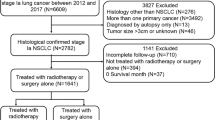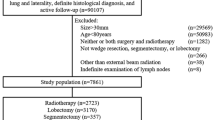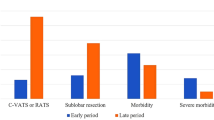Abstract
Purpose
This study aimed to determine the outcomes and prognostic factors associated with octogenarians who underwent pulmonary resection for lung cancer.
Methods/patients
From 2009 to 2018, 76 octogenarians underwent pulmonary surgery for lung cancer at the Kanazawa Medical University, Japan. They were divided into two groups (early and late octogenarians), and their clinicopathological characteristics and outcomes were investigated. Overall survival rates and recurrence-free survival rates were determined using Kaplan–Meier curves. Univariate and multivariate analyses were performed to identify prognostic factors.
Results
Limited surgery was performed more often in the late octogenarian group; however, most perioperative factors were not significantly different between the two groups. The 3-year overall survival and recurrence-free survival rates were 61.2% and 52.8%, respectively. The median observation period was 37.5 (8.9–112.3) months postoperatively. Kaplan–Meier curves showed that age ≥ 85 years (late octogenarian), smoking history, and squamous cell carcinoma on histology were associated with worse survival rates. Multivariate analysis identified age ≥ 85 years (late octogenarian) (p = 0.011) and cigarette smoking (p = 0.025) as unfavorable prognostic factors for overall survival and recurrence-free survival, respectively.
Conclusions
Most octogenarians with an indication for surgery can tolerate pulmonary surgery. However, owing to the limitations of this retrospective, single-center study, future studies involving multiple-institutions are required to confirm our findings.


Similar content being viewed by others
References
The Japan Lung Cancer Society. Guidelines for diagnosis and treatment of the lung cancer 2019. II Non-small cell lung cancer (NSCLC); 1. Surgery. https://www.haigan.gr.jp/guideline/2019/1/2/190102010100.html. Accessed 22 May 2020.
Committee for Scientific Affairs, Ueda Y, Fujii Y, Kuwano H. Thoracic and cardiovascular surgery in Japan during 2007. Annual report by the Japanese Association for Thoracic Surgery. Gen Thorac Cardiovasc Surg. 2009;57:488–513.
Committee for Scientific Affairs, The Japanese Association for Thoracic Surgery, Shimizu H, Endo S, Natsugoe S, et al. Thoracic and cardiovascular surgery in Japan in 2016: annual report by The Japanese Association for Thoracic Surgery. Gen Thorac Cardiovasc Surg. 2019;67:377–411. https://doi.org/10.1007/s11748-019-01068-9.
Charlson ME, Charlson RE, Peterson JC, et al. The Charlson comorbidity index is adapted to predict costs of chronic disease in primary care patients. J Clin Epidemiol. 2008;61:1234–40.
Okada S, Shimada J, Kato D, et al. Clinical significance of prognostic nutritional index after surgical treatment in lung cancer. Ann Thorac Surg. 2017;104:296–302.
Dusselier M, Deluche E, Delacourt N, et al. Neutrophil-to-lymphocyte ratio evolution is an independent predictor of early progression of second-line nivolumab-treated patients with advanced non-small-cell lung cancers. PLoS ONE. 2019;14:e0219060. https://doi.org/10.1371/journal.pone.0219060.
Hu P, Shen H, Wang G, et al. Prognostic significance of systemic inflammation-based lymphocyte–monocyte ratio in patients with lung cancer: based on a large cohort study. PLoS ONE. 2014;9:e108062. https://doi.org/10.1371/journal.pone.0108062.
Toda M, Tsukioka T, Izumi N, et al. Platelet-to-lymphocyte ratio predicts the prognosis of patients with non-small cell lung cancer treated with surgery and postoperative adjuvant chemotherapy. Thorac Cancer. 2018;9:112–9. https://doi.org/10.1111/1759-7714.12547.
Wells JM, Washko GR, Han MK, et al. Pulmonary arterial enlargement and acute exacerbations of COPD. N Engl J Med. 2012;367:913–21.
James DB, Mary KG, Christian W. UICC TNM classification of malignant tumors. 8th ed. Hoboken: Wiley-Blackwell; 2016.
Ministry of Health, Labour and Welfare Homepage. Abridged Life Tables for Japan 2018. https://www.mhlw.go.jp/english/database/db-hw/lifetb18/index.html. Accessed 10 May 2020.
Okami J, Higashiyama M, Asamura H, et al. Pulmonary resection in patients aged 80 years or over with clinical stage I non-small cell lung cancer. Prognostic factors for overall survival and risk factors for postooperative complications. J Thorac Oncol. 2009;4:1247–53.
Chida M, Minowa M, Karube Y, et al. Worsened long-term outcomes and postoperative complications in octogenarians with lung cancer following mediastinal lymph-node dissection. Interact Cardiovasc Thorac Surg. 2009;8:89–92.
Sobue T, Yamamoto S, Hara M, et al. Japanese Public Health Center. Cigarette smoking and subsequent risk of lung cancer by histologic type in middle-aged Japanese men and women: the JPHC study. Int J Cancer. 2002;99:245–51.
Japan Health Promotion and Fitness Foundation Homepage. Adult smoking rate (Ministry of Health, Labor and Welfare National Health and Nutrition Survey). http://www.health-net.or.jp/tobacco/product/pd100000.html. Accessed 10 May 2020 (in Japanese).
Port JL, Mirza FM, Lee PC, et al. Lobectomy in octogenarians with non-small cell lung cancer: ramifications of increasing life expectancy and benefits of minimally invasive surgery. Ann Thorac Surg. 2011;92:1951–7.
Ikeda N, Hayashi A, Iwasaki K, et al. Surgical strategy for non-small cell lung cancer in octogenarians. Respirology. 2007;12:712–8.
Acknowledgements
We would like to express our gratitude to all the patients who participated in the study.
Funding
No funding was received for the study.
Author information
Authors and Affiliations
Contributions
Data analysis was performed by YI, the first draft of the manuscript was written by YI. All the authors contributed equally to the manuscript.
Corresponding author
Ethics declarations
Conflict of interest
All authors have no conflicts of interests to declare.
Ethics approval
Access and use of patient data were approved by the Kanazawa Medical University ethics committee (approval number: I160 and I449).
Consent to participate
Informed consent was obtained from the patients preoperatively and included access to their clinical records.
Consent for publication
All authors consent to the publication of the manuscript.
Availability of data and material
Not applicable.
Additional information
Publisher's Note
Springer Nature remains neutral with regard to jurisdictional claims in published maps and institutional affiliations.
Rights and permissions
About this article
Cite this article
Iijima, Y., Iwai, S., Yamagata, A. et al. Is lung resection appropriate for late octogenarians? Surgical outcomes of patients aged ≥ 80 years with lung cancer. Clin Transl Oncol 23, 1585–1592 (2021). https://doi.org/10.1007/s12094-021-02554-4
Received:
Accepted:
Published:
Issue Date:
DOI: https://doi.org/10.1007/s12094-021-02554-4




